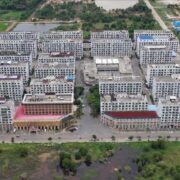Soil and water: Asia-Pacific’s bread and butter

Here, in the world’s most populous region, a crisis is slowly unfolding that involves the earth beneath our feet. The soil that produces the food we eat and supports the livelihood of hundreds of millions of farmers and others, is under threat.
Often referred to as the “Skin of the Earth,” soil acts as a silent steward, supporting the production of 95 percent of the food we eat in this region. It retains water, serves as a habitat for animals, and plays a key role in regulating our climate by storing more carbon than all the world’s forests combined. But the ability of our soils to provide these ecosystem services is increasingly threatened after decades of soil degradation and water scarcity caused by overuse and misuse.
Soil and water rely on each other, and that’s critical to feed a hungry world. In the Asia-Pacific region, some 90 percent of our freshwater is consumed in agricultural activities alone, considerably more than the 75 percent, on average, used by agriculture worldwide. Yet, more than three-quarters of the Asia-Pacific population are now grappling with water insecurity.
Much of this has been caused by mismanagement of our water and soil resources. Unsustainable practices have exacerbated the situation, contributing to the loss of biodiversity in terrestrial and aquatic ecosystems, and further challenging the resilience of agrifood systems facing extreme weather events. The fact that soil is not a renewable resource makes its preservation an even more urgent matter: it can take up to a thousand years to form one centimeter of soil, yet this same centimeter can be destroyed in a few minutes through careless acts of degradation.
To better understand the close relationship between soil and water, it’s a critical necessity for countries to work domestically and cross borders to ensure wider sustainable development in the Asia-Pacific region. While pressure on this soil-water-food nexus is increasing, reversing the degradation is still possible. But we all need to take responsibility and act.
Together, we must promote soil and water management at all levels. We can do our part by changing habits to preserve fresh water each day. Meantime, policymakers and other stakeholders can collaborate in implementing sustainable soil and water management practices. This involves planning and action to ensure the more efficient use of fresh water, promoting sustainable use of fertilizers and pesticides, employing appropriate irrigation methods—including the ways we drain and pump water—and paying more attention to monitoring related data, such as soil and groundwater salinity levels.
Indeed, all land users, particularly farmers, need training on sustainable soil and water management and that means inclusive access to technology transfer. This is crucial for transforming our agrifood systems, making them more resilient to extreme climate events. By doing so, our soils can become richer in carbon and can hold more water, benefiting the interconnected relationship between soil, water, and plants. This not only improves the overall health of the region’s environment but also enhances its ability to mitigate the effects of climate change.
Research has found that Asian soils can sequester 180 megatons of carbon per year if sustainable high-carbon input soil management practices are adopted. Addressing soil degradation requires comprehensive domestic and international efforts involving government policies, research initiatives, and awareness programs.
Initiatives like Thailand’s Glinka World Soil Award and the King Bhumibol World Soil Day Award, which acknowledged the late king’s dedication to sustainable soil management and its role in food security and poverty reduction, serve as exemplary models of localized endeavors. These efforts aim to recognize and encourage sustainable soil practices, fostering awareness and responsible management.
Indeed, we mark Dec. 5 on our calendar as World Soil Day to remind everyone of its importance. Hosted by the Food and Agriculture Organization of the United Nations (FAO), the Global Soil Partnership strives to enhance soil governance and management for food security, climate change adaptation and mitigation, and sustainable development. In a world hungry for solutions, FAO is sowing the seeds of sustainability, emphasizing the importance of understanding and addressing the complex nexus between soil health, sustainable agriculture, biodiversity conservation, and essential ecosystem services.
In doing so, we aim to help countries fulfill the Sustainable Development Goals and achieve better production, better nutrition, a better environment, and a better life for all. As we navigate the multiple challenges of recovery from the pandemic, conflicts, and the need for systemic agrifood systems reform, we should celebrate World Soil Day beyond Dec. 5, as we call for collective action and a daily commitment to safeguard the Earth’s lifeline: our soil, literally our bread and butter. The Jakarta Post/Asia News Network
Jong-Jin Kim is assistant director general and regional representative for Asia and the Pacific at the FAO.
The Philippine Daily Inquirer is a member of the Asia News Network, an alliance of 22 media titles in the region.





















